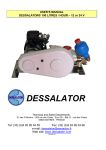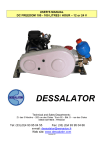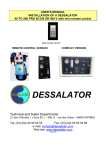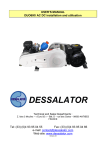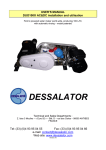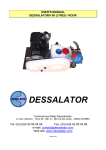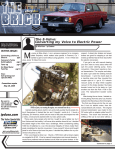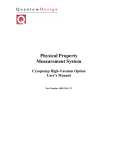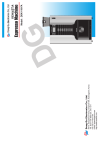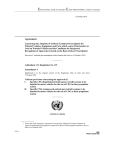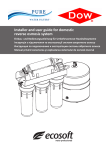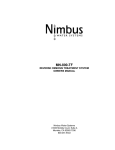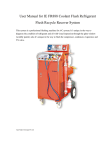Download INSTALLATION AND INSTRUCTIONS FOR USE
Transcript
USER’S MANUAL INSTALLATION OF A DESSALATOR 440 TO 1,000 LITRES / HOUR IN 400 V BEWARE: DO NOT LIFT BY CHASSIS! DESSALATOR Technical and sales departments: Z.I des 3 Moulins – « Euro 92 » – Bât. D – rue des Cistes – 06600 ANTIBES Tel: (33) (0)4 93 95 04 55 Fax: (33) (0)4 93 95 04 66 Email: [email protected] Web Site: www.dessalator.com DESALINATOR 440 TO 1,000 LITRES / HOUR CONTENTS 1. Installation diagrams: Integrated control – Compact version page 1 2. Components supplied by DESSALATOR page 2 3. Installation instructions: 3.1 Pre pump 3.2 Membranes 3.3 Control panel 3.4 Motor unit 3.5 Connection plan page page page page page 4. Instructions for use page 8 5. Reverse osmosis principle 5.1. The membranes page 9 page 10 6. Maintenance: 6.1 Cleaning the membranes 6.2 Sterilizing the membranes page 11 page 12 3 4 5 6 7 7. Filters and power supply 7.1 Basket pre filter 7.2 Filter unit 7.3 Power supply on terminals page 13 8. Troubleshooting page 14 2. COMPONENTS SUPPLIED BY DESSALATOR ACCORDING TO THE CHOOSEN MODEL: Pre pump: It enables water to flow through the pre filters to the HP motor unit. Pre-filters: Stainless steel pre filter - multi cartridges 25 µm 10 Inch (x5): it allows a first filtration. It is supplied with an anode in its cover. Stainless steel pre filter - multi cartridges 5 µm 10 inch (x5): it allows a filtration up to 5µm; It is supplied with an anode in its cover. Motor unit: HP motor, fixed on a frame with silent blocks. Control panel HP motor unit Control panel: The control panel manages the functions of the water maker. Page 2 . WATER MAKER - 440 TO 1,000 LITRES / HOUR 3.1 Installation instructions Pre pump: The pre pump with its rinsing valve3 and its pre filter should be installed in charge and the pressurized fresh water should be connected to the valve. Beware: Please check the rotating direction of the pre pump when starting up the machine. THE PRE PUMP SHOULD NOT BE PLACED WHERE THERE IS A RISK OF WATER SPRAY. Pre pump cable case 400V Pump cable case 400V LP Pump (three-phased motor 240 / 400) Beware: Check the direction of rotation HP pump (Motor 400 / 660V) Phase 1 Phase 1 Phase 2 Phase 2 Phase 3 Phase 3 Earth Earth CAUTION: POWER SUPPLY SHOULD BE SWITCHED OFF BEFORE WORK IS CARRIED OUT. PLEASE DO NOT FORGET TO CONNECT THE CHASSIS TO EARTH ON THE SCREW LOCATED ON THE FRONT PANEL! Page 3 . WATER MAKER - 440 TO 1,000 LITRES / HOUR 3.2 Installation instructions Membrane(s), according to desired water flow: 2 membranes for 440 litres / hour water production. 3 membranes for 660 litres / hour water production. 4 membranes for 1000 litres / hour water production. The number of membranes used depends on the desired water flow. Le nombre de membranes est fonction du débit souhaité. Hose from the HP pump should join the membranes at the red ring1. 1 Recommendation: To facilitate the attachment to the HP stainless steel joins2, it is possible to rotate the heads through 90°, by unscrewing the grey production connectors. Remove the nut covers and loosen the 12 nuts maintaining the unit. Then remove the rod to obtain access, and rotate the membrane end cap using a box wrench to join the stainless steel connector. Reinstall the rod and tighten the unit. Page 4 . WATER MAKER - 440 TO 1,000 LITRES / HOUR 3.3 Installation instructions Panel pictures: 4 8 13 3 12 Beware: The handle is in the electric connection box (Security for shipment) Front panel Back panel 6 Figures for each connection are as follows: - N°8 (blue): HP piping exiting the membranes. - N°6 (blue hose 8/10mm diameter): Production hose exiting the membranes. - N°3: Production hose from panel to tanks. A 15mm inner diameter Tricoflex length will be required which should be connected either to the fresh water tanks or before the fresh water pump, provided there is no constricting valve. - N°12: Waste outlet: 15 mm inner diameter Tricoflex. - N°4: 4mm capillary hose to be connected to the exiting side of the HP stainless steel 5 µm pre filter HP; it indicates on the low pressure gauge the dirtiness of the stainless steel pre filter (6m are provided). - N°13 : 4mm capillary hose to be connected to the entry side of the stainless steel pre filter; it indicates the dirtiness of the sand pre filter. In the case of installing a mineralizing filter, it should be located on the production hose to the tanks. Page 5 . WATER MAKER - 440 TO 1,000 LITRES / HOUR 3.4 Installation instructions HP motor unit: There are two water connections to the pump head: - A ¾ diameter pipe1 from the pre filters. - A 19 mm diameter HP hose2 to the membranes. - Two capillary hoses are connected to the stainless steel pre filter; To disconnect them, please push the black collar and pull the hose at the same time. The HP unit should always be installed horizontally. Do not place it where there is a risk of water spray. The connection should be done as on the scheme below. 2 1 Page 6 . . Page 7 . WATER MAKER - 440 TO 1,000 LITRES / HOUR 4. Instructions for use 1. Ensure the valves are open before starting up the water maker. 2. If the water maker has not been run for several days, rinse it manually with the three-way valve on the pre-pump and start the pre pump. This should be carried out while the water maker is idle and with the pressure regulator open (fully anticlockwise).Rinse for two minutes. Purge in the same time stainless steel prefilters. 3. To start the water maker, the pressure regulator must be open. Switch on. The low pressure pump will run for one minute, after which the HP pump will start automatically. Please check the rotating direction of the pre pump when starting (arrow on the bronze pre pump body). The control panel has two inverters. The one on the left is for rinsing and engages only the low pressure pump (please do not forget to place the pre filter valve on the “rinsing” position before starting it). The other position allows starting the water maker. The manual position allows a continuous working. 4. Turn the pressure regulator dial to the right, until the HP gauge reading is in the green zone. 5. Fresh water quality and flow into the tank is automatically monitored by the electronic controller. 6. If pressure becomes too high the water maker will cut out and the red indicator will light up. If this occurs, reduce pressure and restart the water maker. 7. If the water maker is not used for extended periods of time, it should be rinsed preferably once a month while starting the pre pump. If not in use for more than two months, remember to sterilize the membranes (with our special sterilization cartridge) for a storage. Note : Fresh water production depends on the temperature of the sea water and on the cleanliness of the pre-filters, together with the right voltage of the generating unit. Page 8 . DESALINATOR 440 TO 1,000 LITRES / HOUR 5. REVERSE OSMOSIS PRINCIPLE What is the reverse osmosis principle used in your desalinating system? Sea water is forced at high pressure through the membranes which act as “molecular sieves”, only allowing pure fresh water to pass through. Most dissolved solid particles will not penetrate the membranes. This waste, along with remaining saline solution, will flow on the surface of the membranes and will be rejected. Not all particles dissolved in sea water can be eliminated. The system is designed to reject 99% of the TDS (Totally Dissolved Solids), approximately 2% of the 35.000 ppm / TDS will pass through the membranes. This guarantees drinking water with a TDS value of 500 (average). Please note that the drinking water with produced by your reverse osmosis system is essentially sterile, however, your fresh water storage should be treated periodically with a slight dose of chlorine (or iodine) to ensure it remains consumable. Pay attention not to allow pure chlorine (or a too high dose of chlorine) into the desalination system, as this could damage the device. How does your water maker work? Sea water enters the inlet valve which penetrates the hull. The sea water is then routed by the pre-pump through the 25µm pre-filters. The filters water is forced through the membrane by the HP pump (operating pressure 60 to 65 bars). The pressurized water passes through the surface holes of the membranes depositing the salt and minerals, which are then rejected into the sea with the remaining solution. The now fresh water flows over a detector which measures its salt content: if the desalination achieved is satisfactory, the three-way valve automatically directs the fresh water to the tank. If the salinity values measured by the salinity probe are too high (conductivity >1.000 siemens), the valve will reject the water produced into the sea. The volume of drinking water being treated at any time is monitored by a flowmeter on the control panel. Capacities of drinking water production are giving for a 25°C temperature of sea water. Performances are reduced of 2.5 to 5% for one °C of lower temperature. Page 9 . DESALINATOR 440 TO 1,000 LITRES / HOUR 5.1 THE MEMBRANES MEMBRANES, DELICATE COMPONENTS Reverse osmosis membranes must be carefully maintained as they are the most delicate elements of the reverse osmosis system. We recommend that the maintenance instructions are carefully followed to prevent the membranes from damage and to ensure the guarantee is not invalidated. Maximum production capacity of the water maker is achieved with sea water temperature of 25°C. The functioning of the membranes will vary depending on the temperature of the sea water and on the sailing area. Output drops by approximately 2.5 to 5% for each degree below 25°C. Extreme temperatures: The membranes should not be exposed to temperatures below 0°C.Overpressure due to expansion caused by freezing can rupture the membranes and prevent the salt from being filtered out. The membranes must not be exposed to temperatures above 60°C, as high temperatures may also prevent salt from being removed. Drying out of the membranes: The membranes should be permanently immersed in liquid, either sea water before treatment, fresh water provisionally stored or sterilizing liquid, if the water maker is not used for extended periods of time (Sterilizer is effective for six months and must be replaced after this period of time). Recommendations for use: The various quality and salinity grades of sea water affect both membrane efficiency and the working of the water maker in Marinas. The system is not recommended for use in muddy or polluted water (briny water, river, Red sea), which can clog and damage the membranes. However, if the water maker has to be used in such conditions, only run it for very short periods and as soon as clean sea water becomes available clean the membranes and run the system without pressure for 5 minutes with the pressure regulator open. Page 10 . DESALINATOR 440 TO 1,000 L/ HOUR 6.1 MAINTENANCE : Cleaning the membranes CAUTION: IN FREEZING CONDITIONS, EMPTY THE GAPMETER ON THE CONTROL PANELS, DISCONNECTING THE PRODUCTION PIPE AND BLOWING OR INJECTING AIR IN THE PIPE. CLEANING THE MEMBRANES: When should the membranes be cleaned? On average after 800 hours working. Under normal conditions, the membranes may be contaminated by mineral residues or biological matter. These residues reduce both the volume of drinking water produced and the amount of salt filtered out. The membranes should be cleaned whenever the volume of water produced is 10 to 15% lower than initial volume. This volume comparison can be made over the first 24 or 48 hours of operation, or when the detector indicates low quality after the probe has been cleaned. If the drinking water produced falls below the normal working specifications : sea water containing a TDS of 35,000 ppm, sea water temperature of 25°C and pressure of 65 bars in green zone, and if production is not improved by rinsing the membranes, then the membranes have to be replaced. Please take in consideration that the volume of drinking water produced is dependent on ideal sea water temperature and pressure in system. Therefore if the volume of drinking water produced falls, it does not mean necessarily that the membranes need to be replaced. Membranes cleaning procedure: 1. 2. 3. 4. 5. 6. Open the regulator valve fully (turning anti-clockwise). Close the inlet and outlet hull valves. Disconnect the inlet and outlet hoses, and place them in a bucket containing 10 litres of fresh water and the cleaning solution. Run the water maker without pressure for 10 minutes and then switch off. Repeat three times then rinse with fresh water for at least 15 minutes. Reconnect the hoses. Page 11 . DESALINATOR 440 TO 1,000 LITRES /HOUR 6.2 MAINTENANCE: STERILIZING THE MEMBRANES STERILIZING THE MEMBRANES When should the membranes be sterilized? Normally, regular monthly rinsing of the membranes may be all that is required to maintain the membranes. If this is not possible, sterilization will be necessary. Sterilizing efficiency doesn’t exceed 6 months. Membranes don’t be sterilized more than twice a year. Between these two operations membranes must be rinsed with fresh water. Abusive concentration of sterilizing can corrode membranes head. Non-observance of these recommendations and the using of other sterilizers cancel all guarantees. Membranes sterilizing procedure: 1. Rinse the water maker with fresh water while placing the three-way valve of the prepump on the side of fresh water then unscrewing to the maximum the regulator (5 minutes). 2. Place sterilizing doses in the pre-filter cartridge, then close again the pre-filter and rinse 2 minutes. 6.3. High Pressure Pump The HP pump is half filled of oil up to the level indicated on the gauge. Normally, the lubrication is made for 500 hours. In case of replacement, use a multi-grade oil 20W40 and do not exceed the level located on the oil dipstick. Caution: The scotch tape placed on the red stopper of oil filling of the HP pump is just here for the transport: it must be removed before the use. 6.4. Mineralizing If a mineralizing cartridge is provided, this one have to be placed on the circuit of water to the tanks. To obtain one dose, use three packets. Page 12 . DESALINATOR 440 TO 1,000 LITRES /HOUR 7. Filters and power supply 7.1 Basket pre filter Sea water position: Normal functioning Fresh water position: Rinsing Waste oulet Fresh water position Sea water 7.2 Pre filter unit The red valves allow purging the filters. 25 µm cartridge filter 5 µm cartridge filter 7 .3 POWER SUPPLY ON TERMINALS 1,2,3: 400V power supply; 4,5,6: High pressure motor connection; 7,8,9 : Low pressure pump connection; 11, 12: pressure switch; 13,14: Quality probe; 15,16: Fresh water solenoid valve; Page 13 . DESALINATOR 440 TO 1,000 LITRES /HOURS 7. TROUBLESHOOTING PROBLEM No reading on the low pressure gauge Noisy HP pump Variations in speed of the electric motors. L-shaped valve CAUSE Valve closed Pre-pump impeller stuck Dirty pre-filters Reduce water inlet or air inlet in the system. Residues in the pump valves. Generating unit too weak. Voltage error Wrong frequency Dirty fuel filter. No rinsing No sea water Handle incorrectly mounted. SOLUTIONS Check valves Turn the pump fan with a screwdriver or clean the pump body. Change the filters. Insure correct size of pipes (diameter), clips and filters secure filters clean. Open the pump head and clean the 6 valves. Service the generating unit and address adjustments and maintenance. Fix the handle correctly. Page 14 .
















